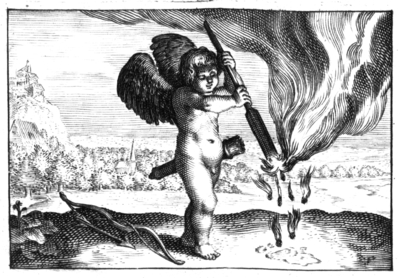Qui me nourrist, m'estaind. [29]

29.
Qui me nourrist, m'estaind.
29.
Qui me nourrist, m'estaind.
Het gene dat de torts ontsteeckt en doetse branden,
Dat selve blustse weer soo haest men keert zijn handen.
Soo gaet het in de min. O wreeden brandt, O brandt,
VVat baet mijn wijsheyt my, oft' treffelick verstandt?
Ick loop her ende weer, ick gae nu soo veel daegen,
En soecke dees en die, om mijnen noodt te klaegen.
Ick moet weer na het vier, de gene die 't my doet
Als oorsaeck van mijn vier, mijn vier oock blussen moet.
Het gene dat de torts ontsteeckt en doetse branden,
Dat selve blustse weer soo haest men keert zijn handen.
Soo gaet het in de min. O wreeden brandt, O brandt,
VVat baet mijn wijsheyt my, oft' treffelick verstandt?
Ick loop her ende weer, ick gae nu soo veel daegen,
En soecke dees en die, om mijnen noodt te klaegen.
Ick moet weer na het vier, de gene die 't my doet
Als oorsaeck van mijn vier, mijn vier oock blussen moet.
Facsimile Images
Translations
Literature
Sources and parallels
-
Parallel in the 1601 edition: motto and subcriptio the same, pictura is mirrored: Qui me nourrist, m’estaind [5] (in: Daniël Heinsius, Quaeris quid sit Amor (c. 1601))
[Compare
![Compare [compare]](/static/images/compare2.gif) ]
]
-
Parallel in the 1608 edition: motto and subscriptio are the same; pictura is mirrored and less detailed in the background.
Qui me nourrist, m’estaind [5] (in: Daniël Heinsius, Emblemata amatoria (1607/8))
[Compare
![Compare [compare]](/static/images/compare2.gif) ]
]
-
A parallel for the French motto and the main pictorial element (mirrored). Quod nutrit, extinguit [96] (in: Otto Vaenius, Amorum emblemata (1608))
[Compare
![Compare [compare]](/static/images/compare2.gif) ]
]
-
A parallel for the pictura: torch, head down. Amor, tela penelopes. [44] (in: Jacob Cats, Sinne- en minnebeelden (1627))
[Compare
![Compare [compare]](/static/images/compare2.gif) ]
]
-
A parallel for the pictura: torch, head down (mirrored). Amor, tela penelopes. [43] (in: Jacob Cats, Proteus (1618))
[Compare
![Compare [compare]](/static/images/compare2.gif) ]
]
References, across this site, to this page:
- Amor, tela penelopes. [43] (in: Jacob Cats, Proteus (1618))
- Amor, tela penelopes. [44] (in: Jacob Cats, Sinne- en minnebeelden (1627))
- Qui me nourrist, m’estaind [5] (in: Daniël Heinsius, Quaeris quid sit Amor (c. 1601))
- Qui me nourrist, m’estaind [5] (in: Daniël Heinsius, Emblemata amatoria (1607/8))
- Quod nutrit, extinguit [96] (in: Otto Vaenius, Amorum emblemata (1608))
Iconclass
Cupid extinguishing a burning torch by holding it upside down- fire (one of the four elements)
[21C]

- landscapes in the temperate zone
[25H1]

- torch - BB - torch held upside down (+ extinguishing; extinguished light, lamp, candle)
[41BB32(+2)]

- archer's weapons: arrow
[45C15(ARROW)]

- archer's weapons: bow
[45C15(BOW)]

- (personifications and symbolic representations of) Love; 'Amore (secondo Seneca)' (Ripa) (+ emblematical representation of
concept)
[56F2(+4)]

- Vitality, Viability, Vital Force (+ emblematical representation of concept)
[58B1(+4)]

- Mortality, Extinction of Life (+ emblematical representation of concept)
[58BB1(+4)]

- proverbs, sayings, etc. (with TEXT)
[86(QUI ME NOURRIST, M'ESTAIND)]

- other non-aggressive activities of Cupid
[92D156]

- attributes of Cupid (with NAME)
[92D18(ARROW)]

- attributes of Cupid (with NAME)
[92D18(BOW)]

- attributes of Cupid (with NAME)
[92D18(QUIVER)]

![[H O M E : Emblem Project Utrecht]](/static/images/rd-small.gif)






















































